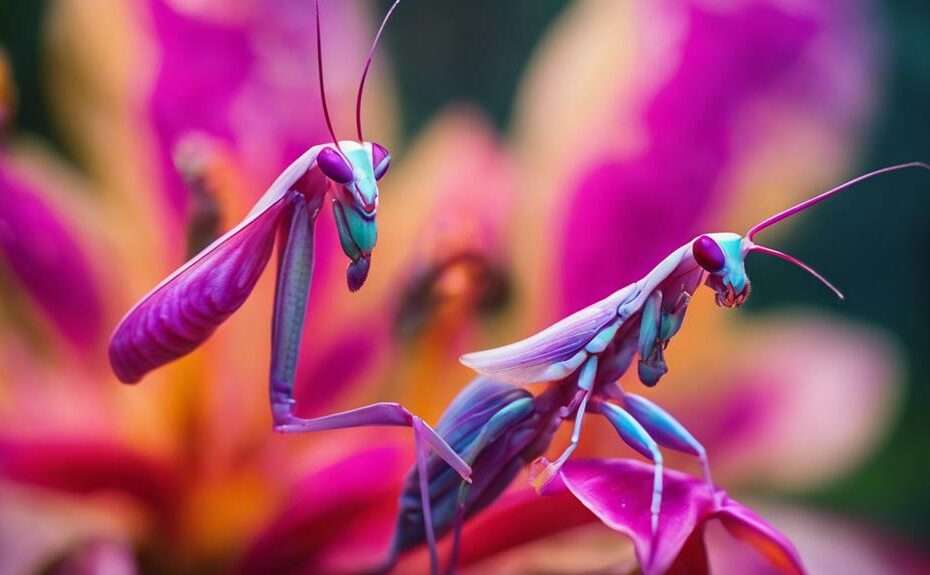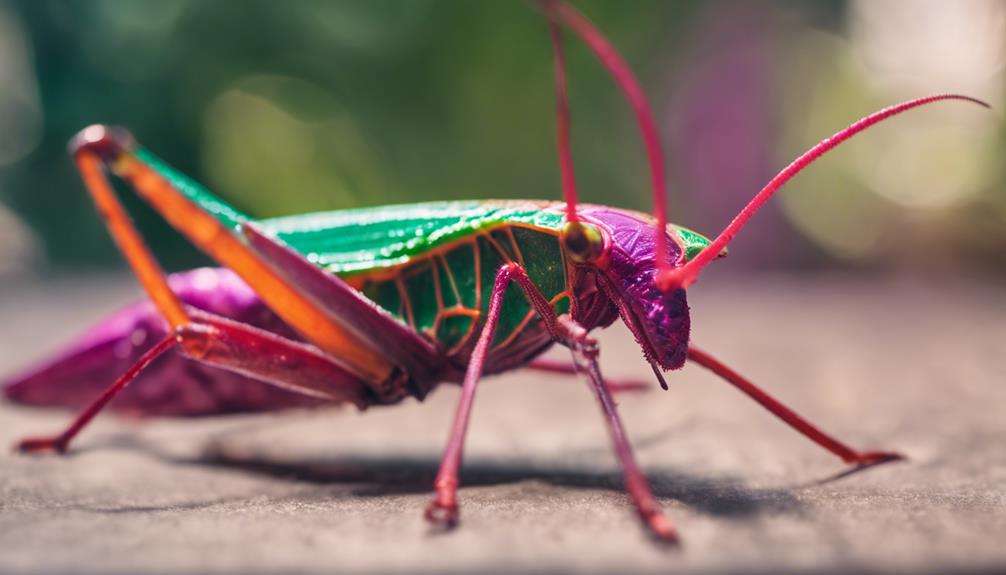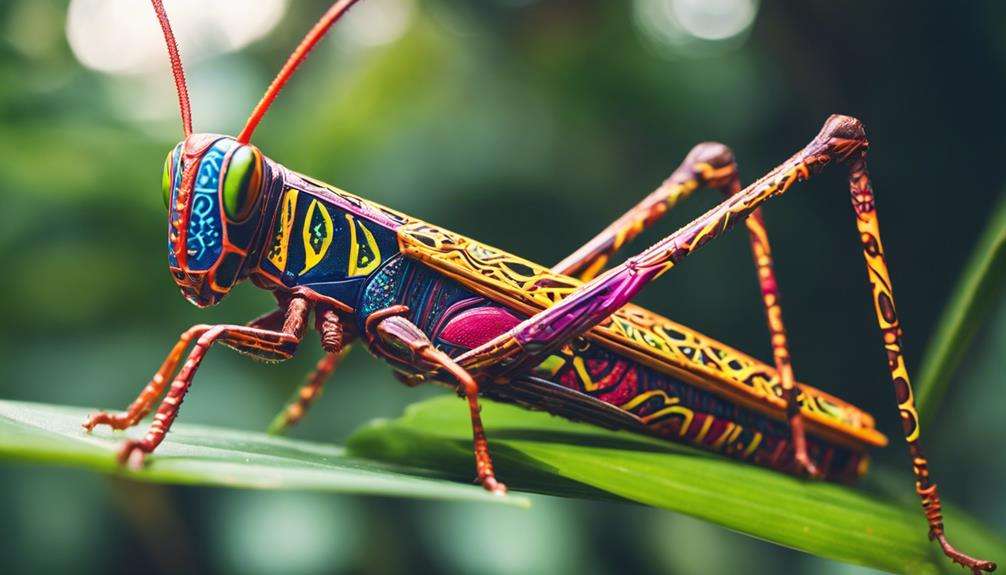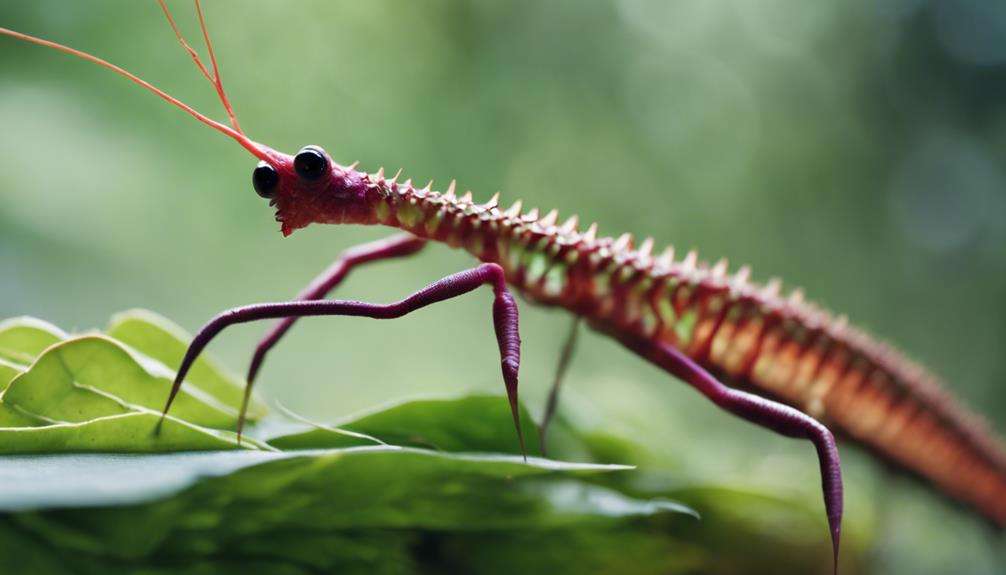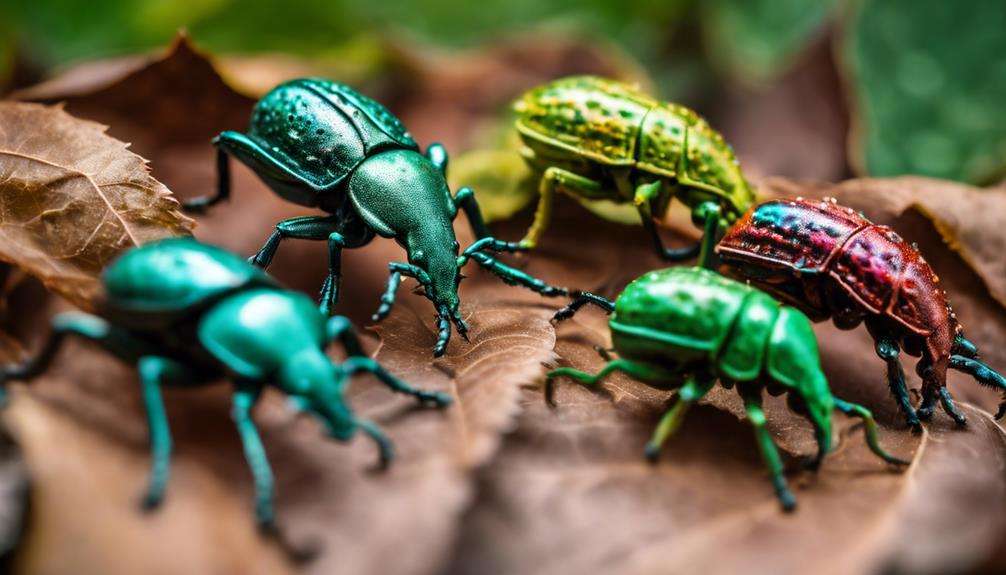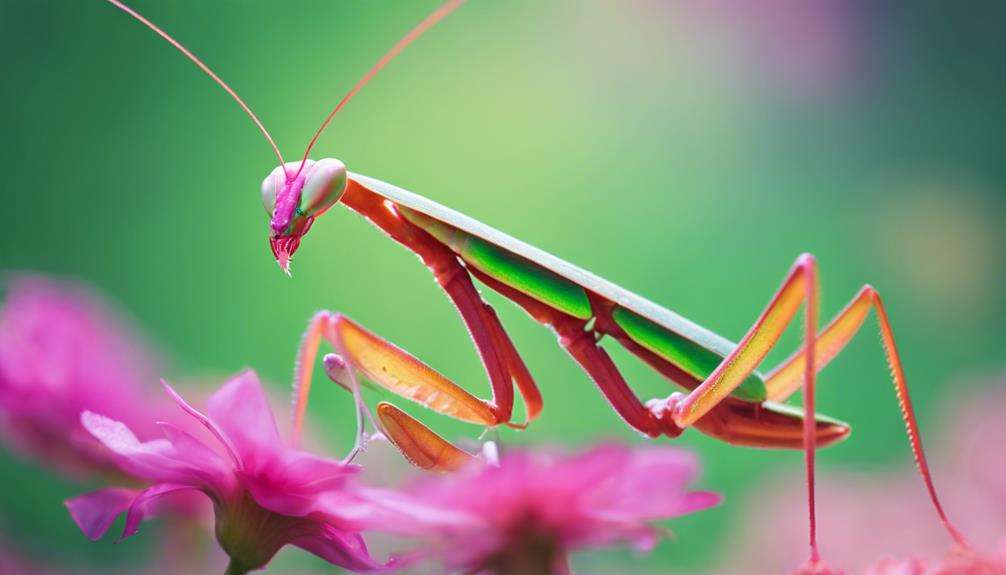Imagine stumbling upon a miniature creature that appears straight out of a sci-fi novel, with colors so vibrant and patterns so intricate that they defy belief.
As you observe this tiny marvel, you can't help but wonder about the secrets it holds and the mysteries waiting to be uncovered.
Curious to learn more about these unconventional insects that challenge perceptions and ignite a sense of awe in even the most seasoned enthusiasts?
Key Takeaways
- Rainbow Stag Beetle and Peacock Spider captivate enthusiasts with vibrant colors and unique behaviors.
- Orchid Mantis and Devil's Flower Mantis showcase remarkable camouflaging techniques in their natural habitats.
- Thorn Bug and Lantern Fly exhibit fascinating defensive adaptations, blending seamlessly into their surroundings.
- Ghost Mantis and Jewel Caterpillars display intriguing behaviors and mimicry strategies that fascinate insect lovers.
Rainbow Stag Beetle
Native to northeastern Australia, the Rainbow Stag Beetle, also known as Phalacrognathus muelleri, captivates enthusiasts with its vibrant hues and striking appearance. These beetles are like nature's living solar panels, reflecting light off microscopic structures on their exoskeleton to create stunning iridescent colors.
As you take a closer look at these magnificent creatures, you'll be mesmerized by their metallic green bodies and the rainbow-like hues adorning their wing cases. In the United States and around the world, Rainbow Stag Beetles have gained popularity among insect hobbyists for their unparalleled beauty and unique characteristics.
These beetles aren't just insects; they're living works of art that showcase the wonders of nature's color palette. With their captivating appearance and growing presence in the pet trade, the Rainbow Stag Beetle continues to fascinate and delight enthusiasts everywhere.
Orchid Mantis
Transitioning from the captivating Rainbow Stag Beetle, let's now explore the fascinating world of the Orchid Mantis, a master of camouflage and mimicry native to southeast Asia. The Orchid Mantis showcases remarkable adaptations that allow it to blend seamlessly into its floral environment, making it a truly mesmerizing insect for enthusiasts to observe.
- Camouflage Expert: Resembling orchids and flowers, the Orchid Mantis employs mimicry to evade predators.
- Color-Changing Abilities: This insect can change colors, enhancing its camouflage and protective capabilities.
- Stunning Visual Appearance: With patterns and colors that mirror flowers, the Orchid Mantis is a sight to behold in its natural habitat.
- Defensive Mechanisms: When threatened, it releases a noxious odor and uses its bright colors for defense.
- Artistic Resemblance: Known for its flower-like appearance and behavior, the Orchid Mantis showcases nature's remarkable mimicry at its finest.
The Orchid Mantis truly stands out as a fascinating insect that exemplifies nature's ingenious adaptations for survival.
Thorn Bug
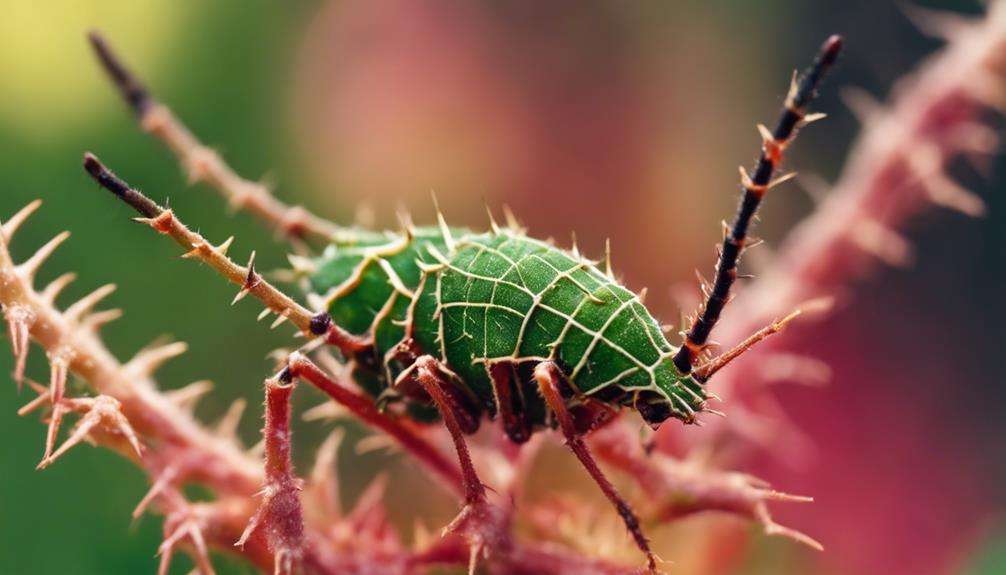
Known for their unique horn-like protrusion on the head, Thorn Bugs are fascinating insects found in South America, Mexico, and south Florida. These tree-dwelling creatures employ their distinctive appearance as a clever defense mechanism, utilizing both horn protection and camouflage tactics to ward off potential predators. The horn not only adds a striking feature to their appearance but also acts as a predator deterrent, making them less desirable targets for birds and other hunters in their natural habitat.
Thorn Bugs blend seamlessly with the bark and foliage of trees, thanks to their exceptional camouflage skills, allowing them to remain hidden and safe from harm. This unique defense strategy showcases their evolutionary adaptation for survival in the wild. Observing Thorn Bugs in their natural environment provides a captivating insight into the intricate ways in which these insects have adapted to thrive and evade predators.
With their intriguing horned appearance and effective defense mechanisms, Thorn Bugs stand out as one of nature's remarkable creations, worthy of admiration and study by insect enthusiasts.
Lantern Fly
With wings resembling vibrant lanterns, the Lantern Fly is a captivating insect native to Asia, known for its unique feeding habits and distinctive appearance. These insects feed on plant sap by piercing the plant with their mouthparts, causing damage and attracting attention due to their honeydew excretion, which in turn draws ants and wasps. The Lantern Fly's wing patterns are striking, featuring distinctive spots that set them apart from other insects.
Despite their beauty, when introduced to the United States, Lantern Flies have become invasive species, posing a threat to local ecosystems and agriculture.
- Known for vibrant and colorful wings resembling lanterns.
- Native to Asia, feeding on plant sap with piercing mouthparts.
- Excrete honeydew, attracting ants and wasps while causing plant damage.
- Introduced to the United States, considered invasive species.
- Distinctive spotted wings often mistaken for moths.
Peacock Spider
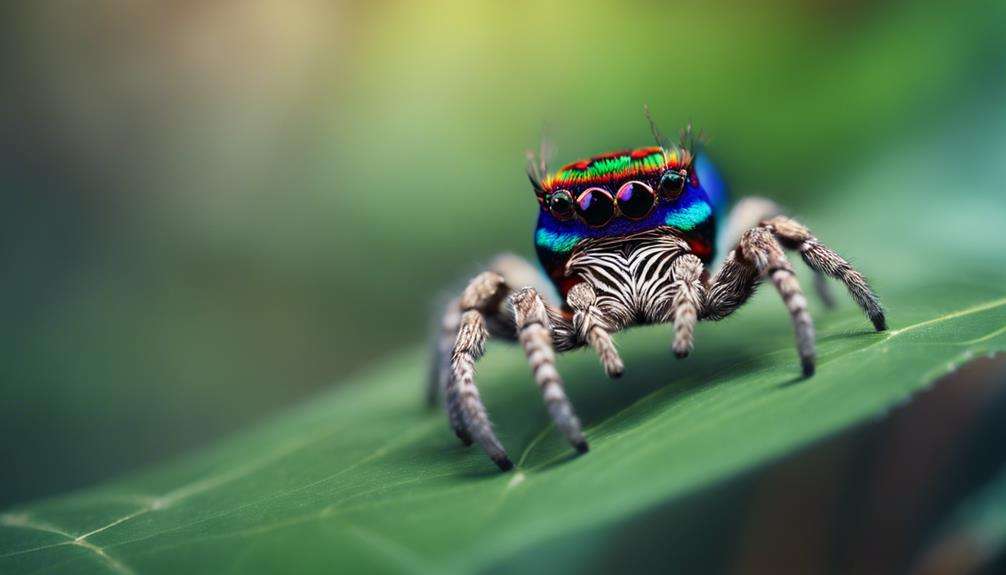
Captivating enthusiasts with their vibrant colors and intricate courtship dances, the Peacock Spider, a genus of tiny jumping spiders found in Australia, is known for its stunning appearances and unique behaviors. These spiders engage in unique courtship rituals, where the males exhibit colorful displays to attract potential mates. One of the most renowned species, Maratus volans, showcases striking blue and red hues, resembling a peacock's tail during the elaborate courtship process. The intricate dances and vibrant patterns displayed by these spiders have made them popular subjects on the internet, captivating audiences worldwide.
Despite their vibrant appearances, Peacock Spiders are harmless to humans, making them a fascinating and safe subject for observation. Their small size and intricate behaviors have contributed to their rise in popularity among insect enthusiasts. By showcasing colorful displays and engaging in elaborate dances, these spiders have carved a niche for themselves in the world of arachnids, standing out for their captivating courtship performances.
Devil's Flower Mantis
The Devil's Flower Mantis, scientifically known as Idolomantis diabolica, is a captivating insect species originating from Africa, renowned for its striking resemblance to a beautiful flower in its resting state. This remarkable insect exhibits fascinating mimicry adaptations, breeding habits, and camouflage strategies that make it a standout species in the insect kingdom.
- Mimicry Adaptations: Devil's Flower Mantises have evolved to mimic the appearance of flowers, which aids in camouflaging themselves from predators while waiting for unsuspecting prey.
- Breeding Habits: These mantises engage in a courtship ritual where the male cautiously approaches the female, showcasing intricate displays to impress and mate with her.
- Camouflage Strategies: Their vibrant colors and intricate patterns not only attract collectors but also help them blend seamlessly into their natural habitat, enhancing their hunting success.
- Aggressive Behavior: Devil's Flower Mantises are known for their aggressive hunting skills, using their precise strikes to capture other insects for sustenance.
- Insect Enthusiasts' Favorite: With their striking appearance and captivating behavior, Devil's Flower Mantises are highly sought after by collectors and photographers alike, adding to their allure in the insect world.
Jewel Caterpillar
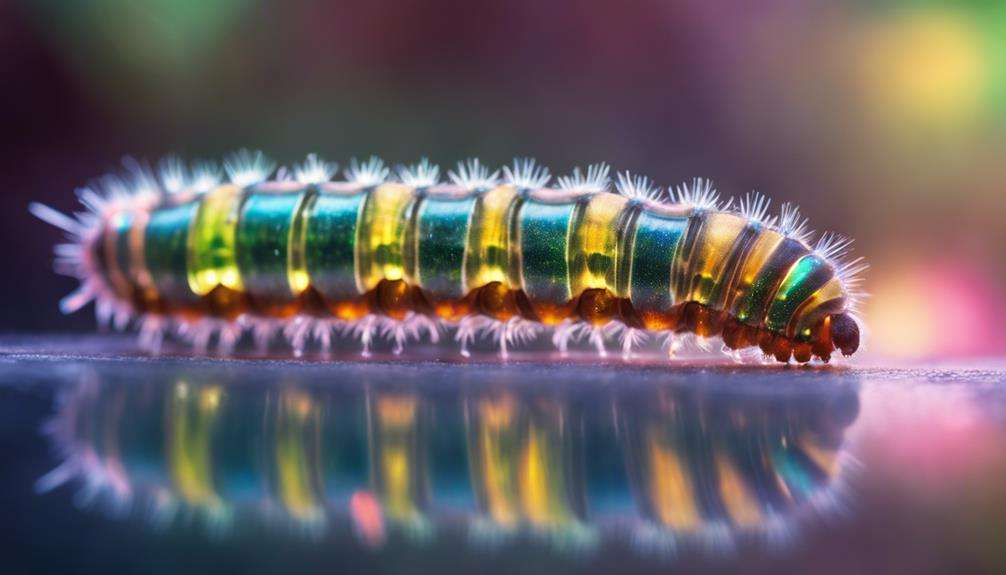
Characterized by their translucent gelatinous bodies and stunning colorful markings, Jewel Caterpillars belong to a unique insect family predominantly found in Central America. These remarkable caterpillars undergo a fascinating metamorphosis process, transforming into Fuzzy Orange Moths. Their metamorphosis is a sight to behold, showcasing nature's incredible transformations.
One of the most striking features of Jewel Caterpillars is their colorful markings. These vibrant patterns not only serve as a defense mechanism but also add to their overall beauty. Their translucent appearance gives them an ethereal quality, making them stand out among other insects.
In addition to their colorful markings, Jewel Caterpillars possess unique physical features that set them apart from other caterpillars. Their gelatinous bodies and distinctive shape make them a captivating subject for insect enthusiasts. Within the insect world, Jewel Caterpillars are truly a gem, captivating observers with their beauty and intriguing characteristics.
Ghost Mantis
The Ghost Mantis, Phyllocrania paradoxa, captivates with its haunting appearance and remarkable hunting techniques. Its body, resembling dried leaves or twigs, serves as impeccable camouflage in the wild.
As skilled ambush predators, these mantises showcase their prowess by swiftly capturing unsuspecting prey.
Haunting Appearance
Appearing as a specter of the insect world, the Ghost Mantis mesmerizes with its uncanny resemblance to a haunting leaf. This unique creature showcases exceptional camouflage techniques, blending seamlessly into its natural habitats by mimicking dead leaves. Here are five fascinating facts about the Ghost Mantis' haunting appearance:
- Ghost Mantises use mimicry strategies to mimic dead leaves, aiding in their predatory behavior.
- Their spectral appearance includes colors like browns, greens, and pinks, enhancing their ghostly allure.
- The evolutionary adaptations of their elongated bodies contribute to their visual deception.
- These mantises move in a 'ghostly' manner, further captivating observers.
- The Ghost Mantis's eerie appearance and behaviors make them a popular choice for insect enthusiasts seeking unique species.
Hunting Techniques
With its deceptive camouflage and patient hunting tactics, the Ghost Mantis expertly stalks its prey, embodying a masterful predator in the insect realm. This remarkable insect, scientifically known as Phyllocrania paradoxa and native to Africa, showcases unparalleled camouflage mastery by mimicking dead leaves or flower petals to execute its ambush tactics.
The Ghost Mantis seamlessly blends into its environment, waiting patiently for unsuspecting prey to approach. Through its skillful swaying movements that imitate leaves or petals, this mantis lures insects closer before striking with predatory precision. Their hunting strategy highlights a combination of patience and precision, reflecting their remarkable adaptation to the surroundings for successful prey capture.
Witnessing the Ghost Mantis in action is a true marvel of nature's ingenuity.
Frequently Asked Questions
What Is the Most Unusual Insect?
The most unusual insect is the Orchid Mantis. This insect showcases bizarre behaviors and unique adaptations to avoid predators. Its ability to change colors for camouflage and resemblance to flowers make it a stunning and intriguing creature.
What Is the Rarest Insect in the World?
You've asked about the rarest insect globally. The Lord Howe Island stick insect, an endangered species, was once thought extinct. Conservation efforts have protected it in unique habitats, showcasing evolutionary survival strategies in biodiversity hotspots.
What Insect Represents Creativity?
Imagine the insect world as a canvas where creative beetles, artistic ants, and imaginative butterflies showcase nature's artistry. These creatures, like the Picasso Bug with its stunning patterns, represent the boundless creativity found in insects.
What Do You Call an Insect Lover?
You call an insect lover an entomophile. These bug aficionados, also known as arthropod admirers, have a deep passion for entomology. Engaging in insect observation, photography, and conservation, they champion the understanding and protection of insect species.
Conclusion
As you journey through the enthralling world of unusual insects, each tiny creature is a vibrant thread in the intricate tapestry of nature's artistry.
Like a kaleidoscope of colors and shapes, these insects serve as reminders of the boundless creativity and wonder that surrounds us.
Embrace the beauty of the Rainbow Stag Beetle, the elegance of the Orchid Mantis, and the mystique of the Ghost Mantis, for they're nature's masterpieces waiting to be discovered and cherished.
